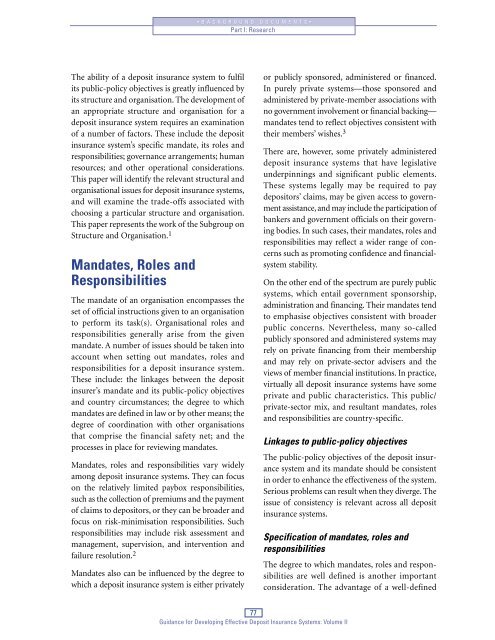Volume II - PDF - International Association of Deposit Insurers
Volume II - PDF - International Association of Deposit Insurers
Volume II - PDF - International Association of Deposit Insurers
- No tags were found...
Create successful ePaper yourself
Turn your PDF publications into a flip-book with our unique Google optimized e-Paper software.
•BACKGROUND DOCUMENTS•<br />
Part I: Research<br />
The ability <strong>of</strong> a deposit insurance system to fulfil<br />
its public-policy objectives is greatly influenced by<br />
its structure and organisation. The development <strong>of</strong><br />
an appropriate structure and organisation for a<br />
deposit insurance system requires an examination<br />
<strong>of</strong> a number <strong>of</strong> factors. These include the deposit<br />
insurance system’s specific mandate, its roles and<br />
responsibilities; governance arrangements; human<br />
resources; and other operational considerations.<br />
This paper will identify the relevant structural and<br />
organisational issues for deposit insurance systems,<br />
and will examine the trade-<strong>of</strong>fs associated with<br />
choosing a particular structure and organisation.<br />
This paper represents the work <strong>of</strong> the Subgroup on<br />
Structure and Organisation. 1<br />
Mandates, Roles and<br />
Responsibilities<br />
The mandate <strong>of</strong> an organisation encompasses the<br />
set <strong>of</strong> <strong>of</strong>ficial instructions given to an organisation<br />
to perform its task(s). Organisational roles and<br />
responsibilities generally arise from the given<br />
mandate. A number <strong>of</strong> issues should be taken into<br />
account when setting out mandates, roles and<br />
responsibilities for a deposit insurance system.<br />
These include: the linkages between the deposit<br />
insurer’s mandate and its public-policy objectives<br />
and country circumstances; the degree to which<br />
mandates are defined in law or by other means; the<br />
degree <strong>of</strong> coordination with other organisations<br />
that comprise the financial safety net; and the<br />
processes in place for reviewing mandates.<br />
Mandates, roles and responsibilities vary widely<br />
among deposit insurance systems. They can focus<br />
on the relatively limited paybox responsibilities,<br />
such as the collection <strong>of</strong> premiums and the payment<br />
<strong>of</strong> claims to depositors, or they can be broader and<br />
focus on risk-minimisation responsibilities. Such<br />
responsibilities may include risk assessment and<br />
management, supervision, and intervention and<br />
failure resolution. 2<br />
Mandates also can be influenced by the degree to<br />
which a deposit insurance system is either privately<br />
or publicly sponsored, administered or financed.<br />
In purely private systems—those sponsored and<br />
administered by private-member associations with<br />
no government involvement or financial backing—<br />
mandates tend to reflect objectives consistent with<br />
their members’ wishes. 3<br />
There are, however, some privately administered<br />
deposit insurance systems that have legislative<br />
underpinnings and significant public elements.<br />
These systems legally may be required to pay<br />
depositors’ claims, may be given access to government<br />
assistance, and may include the participation <strong>of</strong><br />
bankers and government <strong>of</strong>ficials on their governing<br />
bodies. In such cases, their mandates, roles and<br />
responsibilities may reflect a wider range <strong>of</strong> concerns<br />
such as promoting confidence and financialsystem<br />
stability.<br />
On the other end <strong>of</strong> the spectrum are purely public<br />
systems, which entail government sponsorship,<br />
administration and financing. Their mandates tend<br />
to emphasise objectives consistent with broader<br />
public concerns. Nevertheless, many so-called<br />
publicly sponsored and administered systems may<br />
rely on private financing from their membership<br />
and may rely on private-sector advisers and the<br />
views <strong>of</strong> member financial institutions. In practice,<br />
virtually all deposit insurance systems have some<br />
private and public characteristics. This public/<br />
private-sector mix, and resultant mandates, roles<br />
and responsibilities are country-specific.<br />
Linkages to public-policy objectives<br />
The public-policy objectives <strong>of</strong> the deposit insurance<br />
system and its mandate should be consistent<br />
in order to enhance the effectiveness <strong>of</strong> the system.<br />
Serious problems can result when they diverge. The<br />
issue <strong>of</strong> consistency is relevant across all deposit<br />
insurance systems.<br />
Specification <strong>of</strong> mandates, roles and<br />
responsibilities<br />
The degree to which mandates, roles and responsibilities<br />
are well defined is another important<br />
consideration. The advantage <strong>of</strong> a well-defined<br />
77<br />
Guidance for Developing Effective <strong>Deposit</strong> Insurance Systems: <strong>Volume</strong> <strong>II</strong>
















